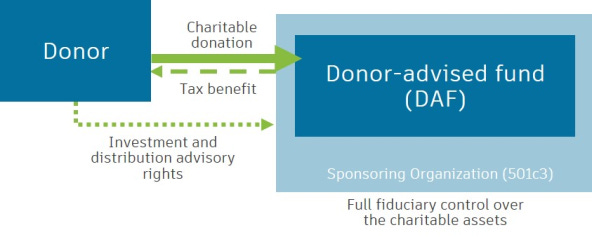Whether you’re building a climate tech startup, scaling an alternative protein venture, or raising an impact fund, you’re probably familiar with this recurring headache: We need more catalytic capital, not just more capital, but capital with the patience, flexibility, and risk appetite to support unproven but high-potential solutions.
As someone who is deeply passionate about innovative financing structures to mobilize more capital into impact-oriented assets—and into the hands of kind-hearted entrepreneurs, fund managers, and builders—I've spent years experimenting with tools ranging from convertible notes with variable debt to revenue share with royalty payments, self-liquidating equity tied to interest payments, and impact equity. I believe financing innovation is as important as product innovation when scaling solutions that matter.
What if I told you that over $230 billion (yes, billion with a B) sits in Donor-Advised Funds (DAFs) in the U.S. alone — and that much of it is waiting patiently, growing tax-free, while changemakers like us hustle to unlock tiny scraps of funding?
This isn’t just a missed opportunity. It’s a design flaw we can hack.
What Are Donor-Advised Funds (DAFs)?
DAFs are philanthropic vehicles where individuals donate assets, take an immediate tax deduction, and then recommend grants or investments from their fund over time. The assets can sit indefinitely—there’s no required payout rate (unlike private foundations). While they’re most often used to make traditional grants, DAFs can also make impact investments that deliver both financial returns and social/environmental impact.
Most impact entrepreneurs and fund managers don’t consider DAFs a funding source. But they should, for three big reasons:
Catalytic Capital—DAFs can tolerate below-market returns, longer horizons, or higher risk if aligned with donor intent. They are perfect for early-stage impact ventures or emerging impact funds.
Patient Capital — No pressure to exit fast; DAF donors may be comfortable with slower liquidity.
Aligned Incentives — DAF investors often care more about impact alignment than maximizing financial returns.
Here’s how it works:
A donor contributes cash, stocks, private business interests, or other assets to a DAF (usually held by a sponsoring organization like a community foundation or national charity).
The donor gets an immediate tax deduction based on the donation's fair market value.
The DAF sponsor legally controls the assets. However, the donor can recommend how funds are distributed — either as grants to nonprofits or as impact investments in mission-aligned enterprises and funds.
The assets can be invested and grow tax-free inside the DAF, compounding the donor’s philanthropic firepower over time.
Unlike private foundations, there is no annual payout requirement. Funds can sit indefinitely until the donor recommends disbursements.
Benefits of DAFs for Donors:
Receive an upfront tax deduction at the time of contribution, even if the funds are distributed over many years.
Tax-Free Growth — Assets in DAFs grow tax-free, maximizing the capital available for grants or investments.
Flexible Giving — No annual payout requirement means donors can recommend grants or impact investments on their timeline.
Privacy and Simplicity — DAFs offer administrative simplicity and can provide anonymity compared to direct giving or setting up a foundation.
Why DAFs Lead to Double Impact
DAFs have the unique ability to create compounding impact:
When DAF capital is deployed into impact assets (like catalytic ventures, impact funds, or mission-driven enterprises), it generates both returns and impact.
These returns can then be recycled, reinvested into new impact opportunities, or granted to aligned nonprofits and initiatives.
In short: Impact assets create impact + returns → returns create more impact investments or donations.
If we’re serious about financing the next wave of impact solutions — whether in climate, food systems, biodiversity, or social equity — we need every tool in the capital toolbox. Donor-Advised Funds represent a sleeping giant of catalytic capital.
As a fund manager and builder who’s navigated both sides (raising for funds and ventures), I believe it’s time more of us made DAF engagement a core part of our capital-raising strategy, not an afterthought.
Your future capital stack might have a DAF-sized secret weapon.
Example Highlight
The Social Finance Impact First Fund is an open-ended fund-of-funds designed to mobilize donor-advised funds (DAFs) and other philanthropic capital into catalytic, impact-first investments. Launched in 2023 by the nonprofit Social Finance, the fund targets early-stage funds and enterprises prioritizing measurable social and environmental outcomes over financial returns. Its investment themes include affordable housing, economic mobility, climate justice, and sustainable agriculture.
The fund has attracted commitments from DAFs at Fidelity Charitable, Vanguard Charitable, the Boston Foundation, and Combined Jewish Philanthropies. Initial investments include the Blackstar Stability Distressed Debt Fund, which supports homeownership in low-income communities; the Afterglow Climate Justice Fund, which finances climate projects in marginalized communities; and RuralWorks, which provides growth capital to rural businesses addressing climate challenges.
Further Reading & Resources
[1] Macpherson, Kearney & Kulow (2018), How to Use Donor-Advised Funds to Make Impact Investments — SSIR.
[2] Social Finance (2021), Unlocking DAFs for Impact-First Investing.
[3] Mission Investors Exchange (2019) — Primer on Using DAFs for Impact Investing
[4] Silicon Valley Community Foundation — Community Foundations as Catalysts for Impact Investing







Super interesting. Had not considered this. Will investigate.